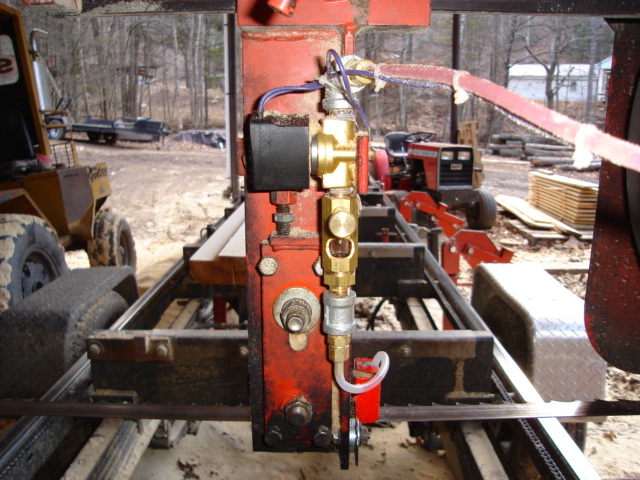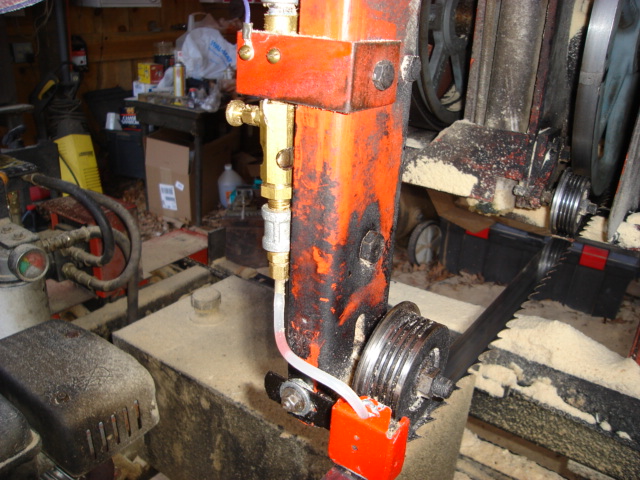Bandmill Blade Sharpening Schedule
Dull blades are bad for many reasons, so it's best to sharpen routinely before any sign of difficulty. Here are estimates of how frequently blades need sharpening, and of how many spare blades to keep on hand in order to keep the mill working. October 26, 2011
Question
I've been reading at the Knowledge Base about band sharpening; one thing I do not understand is the run time. If a blade is said to have been used (or recommended to be used) for 3-4 hours between sharpenings is that actual blade-to-wood contact time, time under tension, or time running at speed? Or is it something else?
Forum Responses
(Sawing and Drying Forum)
From contributor M:
Blade to wood. Of course sometimes that also means blade to dirt, etc. Some woods are more abrasive than others. Some are softer, harder, or drier which affects blade life. It takes a sharper blade to avoid "knot wave", so when sawing knotty logs, you may expect to change the blade more frequently. There is no "one answer fits all" answer to blade sharpness/dulling/changing. I'm sure that other sawyers will offer their view.
From contributor N:
Hours really don't count, it depends on how many bf per hour you saw, bf does. In hard woods I'll get 250 to 500 bf if the wood is fairly clean. In softwoods 500 to 700 bf. I've made over 1000 bf in nice clean wood. When a blade starts to cut crooked or makes too much noise get it off, it's dull.
From contributor G:
It is always better to take a saw off while it is still sharp. Pushing a saw to get that last few cuts tends to lower the quality, slow the mill down and can result in a broken blade. I actually plan to change a saw every two hours, but with my mill that would typically be 600 bf.
From contributor X:
How many blades should one have on hand? I plan on using mine to cut up trees on our property just for our own use.
From contributor E:
My theory is if youíre going to use a resharp program (I do myself due to time) have a minimum of 10 (I have 15) and that way you can saw while you have 1/2 or more resharpened as bulk shipping is less expensive and you still have a few to saw with. I'm blessed that my resharpener is local, and similar to your situation I cut at my spare time pace which is also shared with logging my own timber also. I'm still very green to when to stop sawing and change blades, just because it's removing sawdust doesnít mean it's sharp or accurately cutting!
From the original questioner:
I guess it may seem like a silly question, but I've made some errors assuming things. This is info I will use as a basis, not a rule. I had one blade that didn't work well after a fresh sharpening, so one minute was too long for it; others have worked well all day. Lots of variables, lots of options, lots to consider and just seeing how you guys see things.
From contributor A:
One day I was sawing SYP that was fresh and clean and I had the best time cutting mostly 1x12's and edging on the mill. Then the blade just broke! I changed it out and while I was doing so noted that I had sawn over seven hours with it and had close to 2,500 bdft of lumber stacked around. It was a good blade. Most of the time on the LT40 I get 800 bdft in oak, 1,000 bdft in pine and cedar, and 500 bdft in hickory and hedge. I have a de-barker and use Re-Sharp for my blades. I have about 100 blades for each mill.
From contributor Y:
I try to change the blade before it gets really dull. If it isn't cutting correctly or making noise, itís too late. Sawing with a dull blade will put stress on the blade and get gullet cracks started. I've sharpened plenty of blades, and I can tell when they are sharp by using my fingertip and feeling the very point of a tooth. With practice you can tell how sharp it is by feel. When that very point of the tooth starts to feel rounded, itís time to take the blade off. I always make sure the motor is shut down when I do this, not just disengaged. But with the amount of coffee I drink, the need for breaks gives me plenty of opportunities to check the blade.
From contributor W:
I have a little over 50 blades in my system and usually have about 20 out to be sharpened at any given time. I have tried different brands of blades and sharpening services over the past few years. I was wondering what type, brand, and rake angle you prefer on your mills. About 90% of my sawing is in white knotty pine and the knots really take their toll on a good sharp blade. I get between 200 and 400 bf average out of a resharpened blade. I would really be interested in what set and rake angle you would use in my application. I am really pleased with the quality and pricing of my blade supplier.
From contributor A:
I have WM mills and use WM blades. I have tried others and most are good blades and work well. I use WM blades because I use WM Re-Sharp and they replace my blades as the boxes come in short. When running full tilt we use about 30 blades a week and most of the time have 60 in transit. Most of the time it is a week turnaround time so the UPS guy picks up and drops off at the same time which is very handy. I do not saw white pine but do cut SYP and the knots are very tough. 90% of the time I use 10 degree blades by WM but do have some 7's and 4's and have used their 13 degree blades. The 13's really fly through pine but does not like knots over 1 1/2 inch. The 10 degree will cut ERC and SYP and get through most hardwoods without many problems. When cutting hickory and white oak we mostly switch to 7's.
On the LT70 we saw two hours and change blade at breaks and lunch if we do not hit something (about 1,200 to 1,800 bdft). On the LT40 we saw till dull and that is around 800 bdft in oak and 1,000 bdft in ERC and SYP. Both mills have de-barkers.
A Re-Sharp blade cuts as long as a new one and often cuts smoother. The thing to look at is not the price of the blade but the price per bdft of production. My blade cost is around 1 to 1 1/2 cents per bdft. Take the cost of the blade new and the number of resharps and add them together then divide by the amount of bdft. So if you pay $20 for a new blade and $10 for resharp and do it four times and average 300 bdft per blade use then $20+$10+$10+$10+$10=$60/1,500 bdft makes your cost $0.04 bdft. You can lower it by getting cheaper blades and resharp or extending the blade use by de-barker or better blades and re-sharp service.
From contributor W:
A lot of the pine I saw has some very large knots and are some real ugly logs. I also get some good heart pine and have really not been checking my bf per blade on it. I do change the blade about every two hours and can tell by the feed and sound of the engine as to when the blade is getting dull. I guess we get good blade life based on the type of logs we are sawing. I have discussed rake angle with the guy that does my resharpening. I plan to get a dozen resharpened with a 7 deg. rake angle and feel this will help with the knots.
From contributor Y:
What blades are you running, what thickness, angle and how much set? I noticed on your website that you use a resharpening service; do you ever check how much set is in the blades before you run them? Also, what size band wheels do you have and how big is the motor? Do you drip any diesel or other lube on your blade when sawing pine? The 7 degree hook angle may help, but you need to be aware of how much set you are running and experiment with different amounts of set for different situations.
From contributor W:
I have tried all brands of blades and have run Lenox for a long time. About six months ago I tried a brand called Ripper Blades and they seem to run better than anything I have used in a long time. I have about 30 of them and as the Lenox wears out I am replacing them with Rippers.
All 1 1/4" blades seem to come with .042 set and as of now I am running .045. The wider set works better on the pine for me. This seems to cut more freely. It seems to give room for the lub to work, get the sawdust out of the cut better and less pine sap problems. However based on my past experience with metal cutting tools the 10 deg. rake may be a little too steep for the pine knots. A 7 deg. rake would give me a stronger cutting edge and dissipate the heat much better from the cutting edge. Heat is what destroys cutting edges on any cutting tool except hitting something other than what the tool was designed for. 19" steel band wheels and 27 hp. Motor. The blade lube system is self designed with the felt wiper material coming from Cook's.

Click here for higher quality, full size image

Click here for higher quality, full size image

